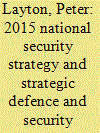|
|
|
Sort Order |
|
|
|
Items / Page
|
|
|
|
|
|
|
| Srl | Item |
| 1 |
ID:
137507


|
|
|
|
|
| Summary/Abstract |
In devising the 2015 National Security Strategy (NSS) and Strategic Defence and Security Review (SDSR), British decision-makers have a choice between trying to shape international affairs to be more favourable or instead planning to respond meaningfully to events that arise. The former grand strategic approach appears favoured however, the latter risk management approach remains the basis for work. That the two approaches are incompatible, distinctly dissimilar and would yield markedly different NSS and SDSR outcomes is generally overlooked. Moreover, opportunism, a third viable approach has been neglected. This article evaluates the three approaches, ascertains their principal advantages and weaknesses and outlines three alternative NSSs and SDSRs based on the different approaches.
|
|
|
|
|
|
|
|
|
|
|
|
|
|
|
|
| 2 |
ID:
123887


|
|
|
|
|
| Publication |
2013.
|
| Summary/Abstract |
The next Strategic Defence and Security Review (SDSR) will be held in 2015. With unfinished business from its 2010 predecessor, and with no sign that UK national strategy is about to escape the grip of austerity, the 2015 SDSR is set to be more complex and contentious than the government might have hoped.
There is a possibility that the review will, yet again, see the three armed services struggle against each other to secure the largest slice of a diminishing cake. The review might also be captured by a fruitless discussion of 'grand strategy'. SDSR 2015 must avoid both of these distractions.
There are four principal concerns arising from SDSR 2010: the feasibility of the Future Force 2020 plan, various capability gaps that must be managed, inconsistencies in the national strategic planning framework, and unresolved concerns about the relationship between society, armed forces and government in the UK.
In response to these concerns, the authors argue for a risk-sharing approach to the SDSR, embracing the widest conceivable range of stakeholders in national strategy: the armed services, government departments and agencies, industry, civil society, and allies and partners.
In UK military circles, inter-service cooperation is known as 'jointery' and is denoted by a certain shade of purple. The effect of austerity is to constrain national strategy, just as the international security environment makes ever more demands upon it. In these circumstances, strategic options must be generated by joint collaboration, denoted by as many shades of purple as appropriate.
|
|
|
|
|
|
|
|
|
|
|
|
|
|
|
|
|
|
|
|
|